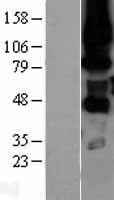PKC eta (PRKCH) (NM_006255) Human Tagged ORF Clone
CAT#: RC205272
PRKCH (Myc-DDK-tagged)-Human protein kinase C, eta (PRKCH)
"NM_006255" in other vectors (7)
Specifications
| Product Data | |
| Type | Human Tagged ORF Clone |
| Tag | Myc-DDK |
| Symbol | PRKCH |
| Synonyms | nPKC-eta; PKC-L; PKCL; PRKCL |
| Vector | pCMV6-Entry |
| E. coli Selection | Kanamycin (25 ug/mL) |
| Mammalian Cell Selection | Neomycin |
| Sequence Data |
>RC205272 ORF sequence
Red=Cloning site Blue=ORF Green=Tags(s) TTTTGTAATACGACTCACTATAGGGCGGCCGGGAATTCGTCGACTGGATCCGGTACCGAGGAGATCTGCC GCCGCGATCGCC ATGTCGTCTGGCACCATGAAGTTCAATGGCTATTTGAGGGTCCGCATCGGTGAGGCAGTGGGGCTGCAGC CCACCCGCTGGTCCCTGCGCCACTCGCTCTTCAAGAAGGGCCACCAGCTGCTGGACCCCTATCTGACGGT GAGCGTGGACCAGGTGCGCGTGGGCCAGACCAGCACCAAGCAGAAGACCAACAAACCCACGTACAACGAG GAGTTTTGCGCTAACGTCACCGACGGCGGCCACCTCGAGTTGGCCGTCTTCCACGAGACGCCCCTGGGCT ACGACCACTTCGTGGCCAACTGCACCCTGCAGTTCCAGGAGCTGCTGCGCACGACCGGCGCCTCGGACAC CTTCGAGGGTTGGGTGGATCTCGAGCCAGAGGGGAAAGTATTCGTGGTAATAACCCTTACCGGGAGTTTC ACTGAAGCTACTCTCCAGAGAGACCGGATCTTCAAACATTTTACCAGGAAGCGCCAAAGGGCTATGCGAA GGCGAGTCCACCAGATCAATGGACACAAGTTCATGGCCACGTATCTGAGGCAGCCCACCTACTGCTCTCA CTGCAGGGAGTTTATCTGGGGAGTGTTTGGGAAACAGGGTTATCAGTGCCAAGTGTGCACCTGTGTCGTC CATAAACGCTGCCATCATCTAATTGTTACAGCCTGTACTTGCCAAAACAATATTAACAAAGTGGATTCAA AGATTGCAGAACAGAGGTTCGGGATCAACATCCCACACAAGTTCAGCATCCACAACTACAAAGTGCCAAC ATTCTGCGATCACTGTGGCTCACTGCTCTGGGGAATAATGCGACAAGGACTTCAGTGTAAAATATGTAAA ATGAATGTGCATATTCGATGTCAAGCGAACGTGGCCCCTAACTGTGGGGTAAATGCGGTGGAACTTGCCA AGACCCTGGCAGGGATGGGTCTCCAACCCGGAAATATTTCTCCAACCTCGAAACTCGTTTCCAGATCGAC CCTAAGACGACAGGGAAAGGAGAGCAGCAAAGAAGGAAATGGGATTGGGGTTAATTCTTCCAACCGACTT GGTATCGACAACTTTGAGTTCATCCGAGTGTTGGGGAAGGGGAGTTTTGGGAAGGTGATGCTTGCAAGAG TAAAAGAAACAGGAGACCTCTATGCTGTGAAGGTGCTGAAGAAGGACGTGATTCTGCAGGATGATGATGT GGAATGCACCATGACCGAGAAAAGGATCCTGTCTCTGGCCCGCAATCACCCCTTCCTCACTCAGTTGTTC TGCTGCTTTCAGACCCCCGATCGTCTGTTTTTTGTGATGGAGTTTGTGAATGGGGGTGACTTGATGTTCC ACATTCAGAAGTCTCGTCGTTTTGATGAAGCACGAGCTCGCTTCTATGCTGCAGAAATCATTTCGGCTCT CATGTTCCTCCATGATAAAGGAATCATCTATAGAGATCTGAAACTGGACAATGTCCTGTTGGACCACGAG GGTCACTGTAAACTGGCAGACTTCGGAATGTGCAAGGAGGGGATTTGCAATGGTGTCACCACGGCCACAT TCTGTGGCACGCCAGACTATATCGCTCCAGAGATCCTCCAGGAAATGCTGTACGGGCCTGCAGTAGACTG GTGGGCAATGGGCGTGTTGCTCTATGAGATGCTCTGTGGTCACGCGCCTTTTGAGGCAGAGAATGAAGAT GACCTCTTTGAGGCCATACTGAATGATGAGGTGGTCTACCCTACCTGGCTCCATGAAGATGCCACAGGGA TCCTAAAATCTTTCATGACCAAGAACCCCACCATGCGCTTGGGCAGCCTGACTCAGGGAGGCGAGCACGC CATCTTGAGACATCCTTTTTTTAAGGAAATCGACTGGGCCCAGCTGAACCATCGCCAAATAGAACCGCCT TTCAGACCCAGAATCAAATCCCGAGAAGATGTCAGTAATTTTGACCCTGACTTCATAAAGGAAGAGCCAG TTTTAACTCCAATTGATGAGGGACATCTTCCAATGATTAACCAGGATGAGTTTAGAAACTTTTCCTATGT GTCTCCAGAATTGCAACCA ACGCGTACGCGGCCGCTCGAGCAGAAACTCATCTCAGAAGAGGATCTGGCAGCAAATGATATCCTGGATT ACAAGGATGACGACGATAAGGTTTAA >RC205272 protein sequence
Red=Cloning site Green=Tags(s) MSSGTMKFNGYLRVRIGEAVGLQPTRWSLRHSLFKKGHQLLDPYLTVSVDQVRVGQTSTKQKTNKPTYNE EFCANVTDGGHLELAVFHETPLGYDHFVANCTLQFQELLRTTGASDTFEGWVDLEPEGKVFVVITLTGSF TEATLQRDRIFKHFTRKRQRAMRRRVHQINGHKFMATYLRQPTYCSHCREFIWGVFGKQGYQCQVCTCVV HKRCHHLIVTACTCQNNINKVDSKIAEQRFGINIPHKFSIHNYKVPTFCDHCGSLLWGIMRQGLQCKICK MNVHIRCQANVAPNCGVNAVELAKTLAGMGLQPGNISPTSKLVSRSTLRRQGKESSKEGNGIGVNSSNRL GIDNFEFIRVLGKGSFGKVMLARVKETGDLYAVKVLKKDVILQDDDVECTMTEKRILSLARNHPFLTQLF CCFQTPDRLFFVMEFVNGGDLMFHIQKSRRFDEARARFYAAEIISALMFLHDKGIIYRDLKLDNVLLDHE GHCKLADFGMCKEGICNGVTTATFCGTPDYIAPEILQEMLYGPAVDWWAMGVLLYEMLCGHAPFEAENED DLFEAILNDEVVYPTWLHEDATGILKSFMTKNPTMRLGSLTQGGEHAILRHPFFKEIDWAQLNHRQIEPP FRPRIKSREDVSNFDPDFIKEEPVLTPIDEGHLPMINQDEFRNFSYVSPELQP TRTRPLEQKLISEEDLAANDILDYKDDDDKV |
| Chromatograms |
CHROMATOGRAMS
 Sequencher program is needed, download here. |
| Restriction Sites |
SgfI-MluI
Cloning Scheme for this gene
Plasmid Map

|
| ACCN | NM_006255 |
| ORF Size | 2049 bp |
| OTI Disclaimer | Due to the inherent nature of this plasmid, standard methods to replicate additional amounts of DNA in E. coli are highly likely to result in mutations and/or rearrangements. Therefore, OriGene does not guarantee the capability to replicate this plasmid DNA. Additional amounts of DNA can be purchased from OriGene with batch-specific, full-sequence verification at a reduced cost. Please contact our customer care team at custsupport@origene.com or by calling 301.340.3188 option 3 for pricing and delivery. The molecular sequence of this clone aligns with the gene accession number as a point of reference only. However, individual transcript sequences of the same gene can differ through naturally occurring variations (e.g. polymorphisms), each with its own valid existence. This clone is substantially in agreement with the reference, but a complete review of all prevailing variants is recommended prior to use. More info |
| OTI Annotation | This clone was engineered to express the complete ORF with an expression tag. Expression varies depending on the nature of the gene. |
| Product Components | The ORF clone is ion-exchange column purified, transfection-ready dried plasmid DNA, and shipped with 2 vector sequencing primers. |
| Reconstitution | 1. Centrifuge at 5,000xg for 5min. 2. Carefully open the tube and add 100ul of sterile water to dissolve the DNA. 3. Close the tube and incubate for 10 minutes at room temperature. 4. Briefly vortex the tube and then do a quick spin (less than 5000xg) to concentrate the liquid at the bottom. 5. Store the suspended plasmid at -20°C. The DNA is stable for at least one year from date of shipping when stored at -20°C. |
| Reference Data | |
| RefSeq | NM_006255.1, NM_006255.2, NM_006255.3, NM_006255.4, NP_006246.2 |
| RefSeq Size | 3868 bp |
| RefSeq ORF | 2052 bp |
| Locus ID | 5583 |
| Cytogenetics | 14q23.1 |
| Domains | C2, pkinase, S_TK_X, TyrKc, DAG_PE-bind, S_TKc |
| Protein Families | Druggable Genome, Protein Kinase |
| Protein Pathways | Tight junction, Vascular smooth muscle contraction |
| MW | 77.8 kDa |
| Gene Summary | 'Protein kinase C (PKC) is a family of serine- and threonine-specific protein kinases that can be activated by calcium and the second messenger diacylglycerol. PKC family members phosphorylate a wide variety of protein targets and are known to be involved in diverse cellular signaling pathways. PKC family members also serve as major receptors for phorbol esters, a class of tumor promoters. Each member of the PKC family has a specific expression profile and is believed to play a distinct role in cells. The protein encoded by this gene is one of the PKC family members. It is a calcium-independent and phospholipids-dependent protein kinase. It is predominantly expressed in epithelial tissues and has been shown to reside specifically in the cell nucleus. This protein kinase can regulate keratinocyte differentiation by activating the MAP kinase MAPK13 (p38delta)-activated protein kinase cascade that targets CCAAT/enhancer-binding protein alpha (CEBPA). It is also found to mediate the transcription activation of the transglutaminase 1 (TGM1) gene. Mutations in this gene are associated with susceptibility to cerebral infarction. [provided by RefSeq, Sep 2015]' |
Documents
| Product Manuals |
| FAQs |
Resources
Other Versions
| SKU | Description | Size | Price |
|---|---|---|---|
| SC116250 | PRKCH (untagged)-Human protein kinase C, eta (PRKCH) |
USD 310.00 |
|
| SC323473 | PRKCH (untagged)-Kinase deficient mutant (K384M) of Human protein kinase C, eta (PRKCH) |
USD 760.00 |
|
| RG205272 | PRKCH (GFP-tagged) - Human protein kinase C, eta (PRKCH) |
USD 460.00 |
|
| RC205272L1 | Lenti ORF clone of Human protein kinase C, eta (PRKCH), Myc-DDK-tagged |
USD 768.00 |
|
| RC205272L2 | Lenti ORF clone of Human protein kinase C, eta (PRKCH), mGFP tagged |
USD 768.00 |
|
| RC205272L3 | Lenti ORF clone of Human protein kinase C, eta (PRKCH), Myc-DDK-tagged |
USD 620.00 |
|
| RC205272L4 | Lenti ORF clone of Human protein kinase C, eta (PRKCH), mGFP tagged |
USD 620.00 |
{0} Product Review(s)
Be the first one to submit a review






























































































































































































































































 Germany
Germany
 Japan
Japan
 United Kingdom
United Kingdom
 China
China



